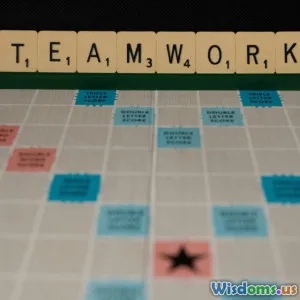
How to Resolve Workplace Conflicts Without Losing Credibility
8 min read Discover effective strategies to handle workplace conflicts while maintaining your professionalism and credibility. (0 Reviews)
How to Resolve Workplace Conflicts Without Losing Credibility
Introduction
Conflicts in the workplace are inevitable. Whether it’s a misunderstanding between colleagues, a clash of ideas, or differences in values, workplace conflicts can undermine productivity, morale, and overall team cohesion. However, resolving such issues presents a challenge: how do you address friction head-on without sacrificing your professional reputation or credibility?
This article dives deep into actionable ways to handle workplace disputes proficiently. By examining effective communication techniques, emotional intelligence, conflict resolution frameworks, and real-life case studies, you will gain a thorough understanding of how to tackle conflicts in a way that reinforces your reputation as a credible and constructive team member.
Understanding the Stakes: Why Credibility Matters in Conflict Resolution
Before exploring methods, it’s crucial to comprehend why preserving credibility matters during conflict resolution. Credibility influences your influence, trustworthiness, and long-term relationships within a professional setting. According to a Gallup survey, employees with high credibility leaders demonstrate 27% higher engagement and are less likely to experience workplace dissatisfaction.
Failing to maintain credibility can lead to stories of unprofessionalism or bias, which often derail not only career progression but also future collaborative efforts.
Identify the Root Cause Clearly
A. Active Listening and Observation
Successful conflict resolution starts with clarity. Active listening entails fully concentrating on what the other party is expressing — verbally and non-verbally — without preparing rebuttals or judgments simultaneously.
Example: Imagine two team members disagreeing over project timelines. Instead of jumping to defend your timetable, listen carefully to their concerns. They might reveal overlooked factors such as resource constraints or client demands. Such insights pave the way for creative compromises.
B. Asking Open-Ended Questions
Encourage dialogue with open-ended questions like, “Can you help me understand what concerns you most about this deadline?” This approach invites transparency rather than defensiveness.
Employ Emotional Intelligence (EI)
Emotional intelligence is the ability to recognize, understand, and manage your own emotions and those of others. High EI professionals tend to navigate workplace tensions with empathy and tact.
Benefits of Emotional Intelligence in Conflict Resolution
- Reduced misunderstandings: By regulating emotional responses, you prevent escalations born from frustration or anger.
- Stronger connections: Insight into others’ emotional states fosters cooperation.
Tips to Enhance Your EI during Conflicts
- Pause before responding to maintain composure.
- Acknowledge emotions without necessarily agreeing. For instance, “I see this is important to you, and I want us to find a fair solution.”
Utilize Structured Conflict Resolution Techniques
Structured frameworks provide blueprints for tackling conflicts constructively.
The Interest-Based Relational Approach
This common approach focuses on:
- Separating people from the problem: Do not personalize the conflict.
- Understanding interests, not positions: Identify underlying needs rather than rigid stances.
- Generating options collaboratively: Work on win-win solutions.
- Using objective criteria: Base decisions on facts rather than emotions.
Real-World Insight: At Google, teams are encouraged to engage in “psychological safety” rounds to voice concerns openly, avoiding personal attacks and focusing on factual, interest-based discussions that lead to innovation.
Mediation and Third-Party Perspective
Sometimes internal resolution needs external intervention. HR professionals or trained mediators can facilitate dialogue, ensure neutrality, and help uncover mutually agreeable solutions.
Communicate with Respect and Assertiveness
Balanced Communication
Avoid passive, aggressive, or passive-aggressive behavior. Assertiveness means expressing your viewpoint confidently while honoring others’ perspectives.
Example Dialogue:
- Passive: "I guess we’ll just do it your way."
- Aggressive: "Your idea is completely wrong."
- Assertive: "I have some concerns about the timeline. Could we discuss possible adjustments that meet both our needs?"
Strong communication enhances credibility by demonstrating professionalism under pressure.
Follow-Up and Accountability
Conflict resolution does not end once an agreement is reached.
- Summarize key points and solutions to ensure shared understanding.
- Agree on concrete next steps and responsibilities.
- Schedule follow-ups to assess progress and adjust if necessary.
This follow-through signals reliability and a commitment to collaborative success.
Case Study: Turning Conflict into Opportunity
Scenario
A marketing manager, Lisa, faced recurring clashes with a graphic design lead, Jorge. Their disagreements about creative direction threatened project deadlines and team morale.
Resolution Strategy
- Lisa invited Jorge for an honest conversation, emphasizing a desire to understand rather than to win.
- They employed the Interest-Based Relational approach, discovering both prioritized customer engagement, despite different aesthetics preferences.
- Leveraging emotional intelligence, Lisa acknowledged Jorge’s passion and steered the focus back to shared goals.
- A mediator helped outline agreed standards for creative inputs.
Outcome
The conflict resolution improved their working relationship. The project ultimately succeeded with a better-designed campaign, setting a precedent for future collaboration across departments.
Common Pitfalls to Avoid
- Ignoring conflicts: Suppressing issues often exacerbates them.
- Taking things personally: Don’t confuse criticism of ideas with attacks on character.
- Overreacting emotionally: It hinders objectivity.
- Dominating conversations: Give space to others to foster openness.
Conclusion
Resolving workplace conflicts without losing credibility hinges on a blend of self-awareness, effective communication, structured approaches, and a commitment to mutual respect. It is an opportunity not only to settle disputes but to build trust, foster teamwork, and elevate leadership qualities.
Employ these strategies responsibly, and you will transform conflicts from damaging tensions into catalysts for innovation and professional growth, enhancing your standing and influence within your organization.
Remember, credibility is earned through integrity and empathy, especially when navigating challenges.
References:
- Gallup State of the American Manager Report (2017)
- Google's Guide to Psychological Safety
- Fisher, Ury, Patton – "Getting to Yes: Negotiating Agreement Without Giving In"
- Mayer, J.D., Salovey, P., & Caruso, D.R. (2004). Emotional Intelligence
Rate the Post
User Reviews
Popular Posts



















